Japan
Wood Products Prices
Dollar Exchange Rates of 25th
Sep
2021
Japan Yen 111.74
Reports From Japan
State of Emergency lifted
The government has ended the state of emergency for
Tokyo and 18 prefectures as infections have declined from
their peak. Infections in Japan have been falling since the
record of 25,876 cases on 20 August. A total of 1,147
cases were confirmed on 27 September. When lifted, this
will be the first time since April that no part of Japan was
under restrictions. Restrictions will be eased in stages with
Prefectural Governors deciding on which antivirus
measures should remain.
Japan needs to simultaneously curb the spread of COVID-
19, promote economic activity and implement reform
measures to improve the business environment according
to a recent government white paper on the economy. With
the nation struggling to contain the pandemic, it is vital to
build an economy capable of responding flexibly to
emergencies such as supply-chain disruption and climate
change, according to the white paper.
The white paper calls for practical approaches, including
the use of vaccination certificates, to revive consumption
and support corporate activities.
See:
https://english.kyodonews.net/news/2021/09/023a70c43ebdjapan-needs-resilient-economy-to-overcome-new-challengeswhite-paper.html
Consumer confidence gets a boost
Household spending is expected to pick up as the state of
emergency around the country has been lifted. Although a
decision on the lifting of restrictions was not announced untl late
September anticipation that this would be the case gave
consumer confidence a boost. On a more sobering note, hospitals
are readying for the next wave of infections as people begin
trying to get back to a more normal life and as commuters fill the
trains.
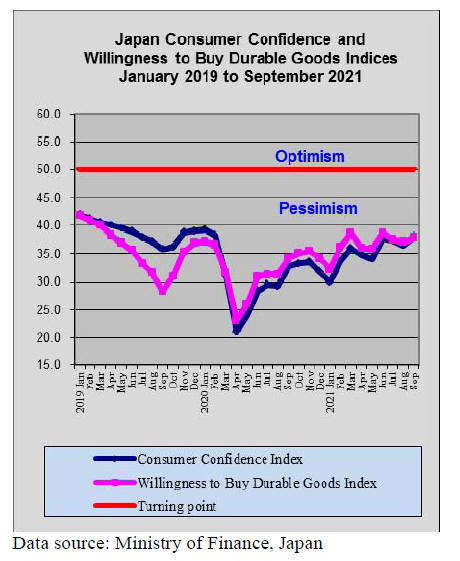
Despite pandemic demand for land firm
Average land prices in Japan as of 1 July fell around half a
percent from the previous year, a decline for the second
consecutive year. However, housing demand, sustained by
low-interest rates, was firm even before the pandemic
pushing up residential land prices in urban residential
areas.
See:https://www.mlit.go.jp/hakusyo/mlit/r01/hakusho/r02/pdf/English%20Summary.pdf
August housing starts were around 7% higher compared to
August 2020 but have now reached about the same level
as in pre-pandemic August 2019. The slight dip in August
starts compared to July is because of the holidays period.
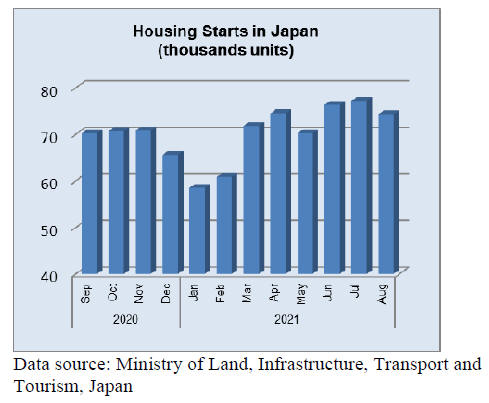
Yen tilts weaker again, exporters happy
The US dollar continued to show strength against most
major currencies in late September including the yen
Market analysts are suggesting the yen could drop to
around 112 to the dollar, a level it has not reached since
early 2020.
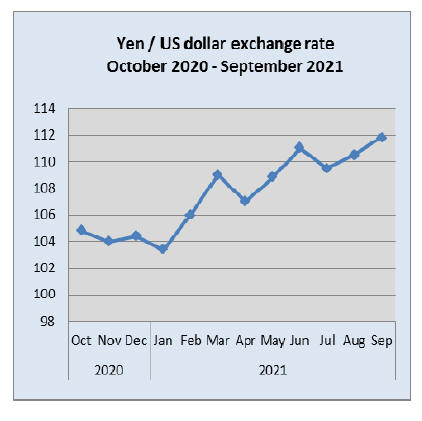
Import update
Furniture imports
Japan¡¯s imports of wooden furniture recovered in the
second half of 2020 and have continued at levels seen in in
pre-pandemic years. The country experienced a serious
forth wave of infections that has only now started to
subside but even this did not result in any noticeable
decline in the value of wooden office and kitchen furniture
imports. However, thare has been a recent correction in the
level of wooden bedromm furniture imports.
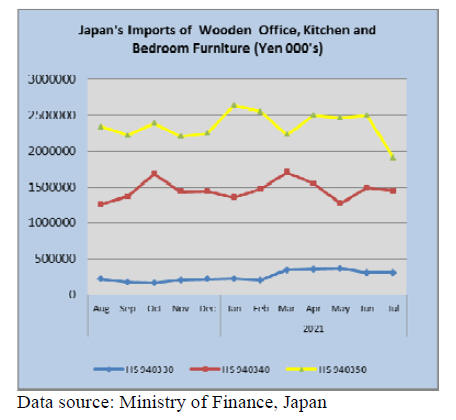
Office furniture imports (HS 940330)
Year on year, the value of imports of wooden office
furniture (HS940330) rose over 20% in July, a result of the
lower imports in 2020 during the early days of the
pandemic. Compared to the value of June imports there
was little change in July.
The top shipper of wooden office furniture in July this
year was China which saw its share of imports rise to
86%. This dented to arrivals from the other two main
suppliers Indonesia and Poland which together could only
secure a 3% share each. Compared to the value of June
imports shipments from suppliers in China jumped around
30%.
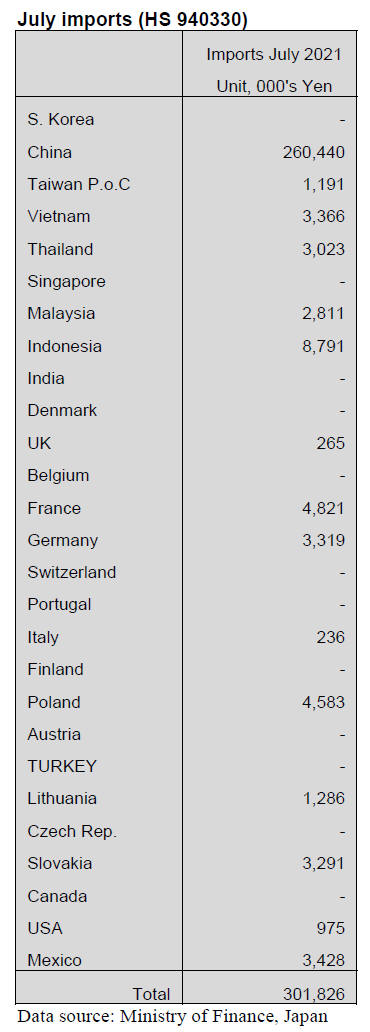
Kitchen furniture imports (HS 940340)
The value of imports of wooden kitchen furniture in July
was little changed from that in June which is bringing
down the overall third quarter imports. Over 90% of
imports of wooden kitchen furniture were from shippers in
just 3 countries, the Philippines (51% of imports),
Vietnam (33%) and China (9%).
It was only shippers in the Philippines that secured a rise
in the share of imports in July. Year on year and month on
month July 2021 import values were largely unchanged.
In June this year there were sizeable imports of
wooden
kitchen furniture from European suppliers notably
Germany and Italy but this was not maintained in July.
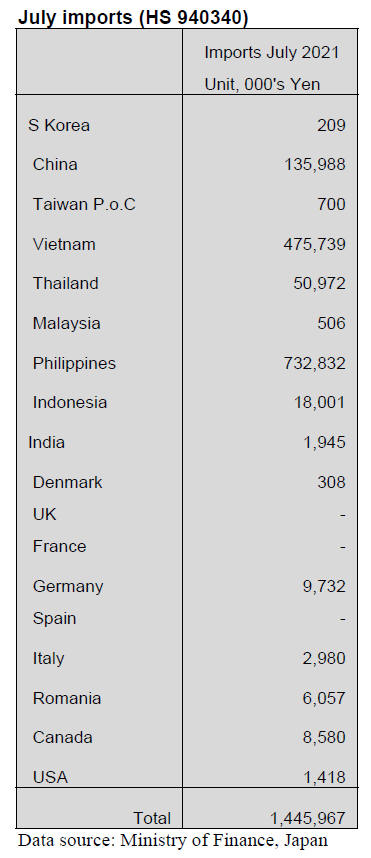
Bedroom furniture imports (HS 940350)
The value of Japan¡¯s imports of wooden bedroom
furniture plunged in July this year dropping 17% year on
year and by a massive 24% compared to the value of June
imports. The main suppliers in July were manufacturers in
China, Vietnam and Thailnd and all three saw the value of
shipments fall compared to June.
It is unlikely that the shortage of shipping containers is
behind the steep drop in the value of imports as no such
drop has been observed for other categories of furniture.
There was no similar drop in July imports in either 2019 or
2020 so the correction is likely to be due to domestic
demand changes.
In July this year the top shippers were from China (66% of
July imports) Vietnam (28%) and Thailand (2%).
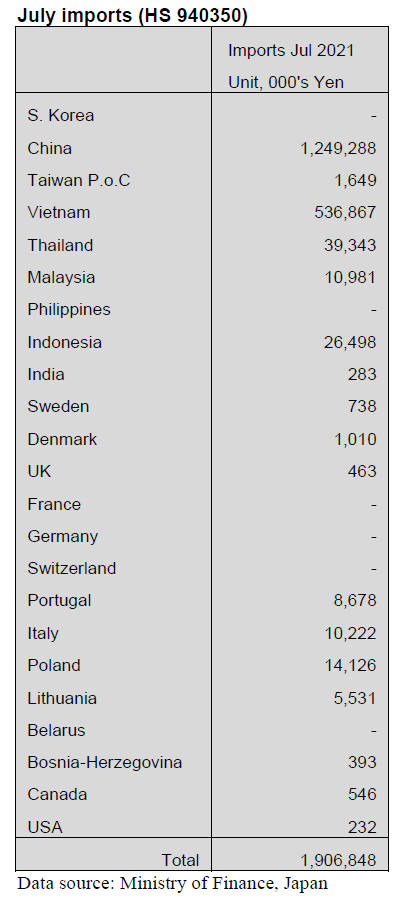
Trade news from the Japan Lumber Reports (JLR)
The Japan Lumber Reports (JLR), a subscription trade
journal published every two weeks in English, is
generously allowing the ITTO Tropical Timber Market
Report to reproduce news on the Japanese market
precisely as it appears in the JLR.
For the JLR report please see:
https://jfpj.jp/japan_lumber_reports/
South Sea (tropical) logs and lumber
Log production in Malaysia remains sluggish as workers
are short at logging sites and the administration offices run
on short time so log production continues slow. Log orders
from India is active. Japanese demand is decreasing for
logs with limited number of ships so even if log
production improves in producing regions, there will not
be any large increase of log demand.
Price increase on Chinese made free board is pausing now
since the dealers in Japan are cautious to make future
purchase by uncertain future market. Also the
manufacturers carry large order balance and deliveries are
now delaying. Chinese made Russian red pine lumber
prices are firm because Russia is restricting export of red
pine lumber.
Indonesian mercusii pine lumber production is affected by
decreasing number of workers by COVID 19 and shortage
of containers.
Imported wood fuel in the first half
The amount of imported wood pellet in January to June
2021 is getting higher than before. Since the amount of
wood pellet from Vietnam is over 30% up and also the
amount from Canada increased a lot at same months last
year. The total amount of imported wood pellet is 150%
more than last year.
The amount of PKS is not as much as Japanese companies
wanted but Indonesian PKS is increasing. The total
amount of imported wood pellet in January to June 2021 is
141,905 tonne, 50.4% higher than the same periods in
2020. About 3,000,000 tonne would be imported in this
year.
The imported wood pellet is from Vietnam for 712,297
tonne, 34,6% more, from Canada for 513,440tonne, 76,7%
more and from Malaysia for 80,336tonne, 13.9% less than
the same months of 2020.
Due to new biomass power generation plants in Japan,
such as Makita biomass power generation plant in
Fukuoka with power output of 75,000kw, Ichihara
biomass power generation plant in Chiba with power
output of 4,990kw and Kaita power generation plant in
Hiroshima with power output of 112,000kw are in
operation which need a lot of wood pellet.
Japan bought only 31 tonne of wood pellet in 2020, but in
this year Japan has already bought 26,967 tonne more in
2021. Nearly 4,000,000 tonne in a year by just one
American company would be imported to Japan in the
future. However, the total amount of imported PKS is
1,114,649tonne, 10.1% increased same months last year.
The volume from Indonesia is 918,635 tonne, 20.1% up
and Malaysia is 196,014 tonne, 20.8% down.
This is because new biomass power generation plants in
Japan prefer to use wood pellet instead of PKS. Also the
lockdown in Malaysia 2020 due to COVID-19 caused a
confusion the supply of PKS for Japan. According to a
trading company in Japan, some biomass power
generation plants consume domestic wooden pellet
because PKS is very expensive now.
North American logs
After forest fire season is over on the West Coast of the
U.S.A., FAS log prices for Japan for September shipment
are reported to be down by US$20 per M Scribner but
ocean freight continues escalating and US$100 increase in
last several weeks.
North American lumber market prices of 15 average
structural grade lumber for the first week of September are
US$395 per MBM, which stopped skidding after 15 weeks
but green Douglas fir 2x4 prices (standard & better) are
less than US$300 at US$285 per MBM FOB Portland.
Sawmills¡¯ profitability is deteriorating and many
sawmills
are curtailing the production so log purchase activities are
simmering down.
Regardless of weaker log prices, Yen¡¯s cost for sawmills
is higher because of strong ocean freight so the largest
lumber manufacturer, Chugoku Lumber raised the sales
prices on Douglas fir KD square and beam since October 1
by 10,000 yen per cbm.
Meantime, Canadian side is different with strict harvest
restriction in Southern part of Vancouver Island and
availability of logs is very difficult and export prices of
logs are inflating. Douglas fir log prices have been
advancing US$5 every month and present prices are
US$150 per cbm FAS.
Ocean freight increased by US$15 per cbm so CIF prices
are about 28,000 yen per cbm FOB truck port yard, about
2,500 yen increase. Domestic plywood mills are short of
domestic logs with soaring prices and they wish to have
Canadian Douglas fir logs even with high prices but the
importers are not able to satisfy enough.
Forestry Agency¡¯s 2022 budget request
Total of 346.2 billion yen is requested for the budget of
the Forestry Agency to perform new forest and forest
industry plan approved by the Diet in June. This is 14%
more than previous budget. 22.4 billion yen is allocated
for measures of wood industry green growth including
subsidy to deal with increasing wood processing facilities
when imported wood products are short in supply.
The main subject is green growth in forestry and forest
industry to realize carbon neutral age. 14.6 billion yen is
requested for facilities of wood processing and distribution
business and of nursery and seedlings.
In particular, wWood processing facilities are to deal with
shortage of imported wood products and domestic wood
should cover such shortage. For instance, such facilities
like processing large diameter logs to produce beam
lumber, which share of imported materials is high. 2.2
billion yen is requested for non-residential wood buildings
in which one billion is allocated for use of fire proof wood
in urban areas and another one billion is allocated for
promoting use of CLT and LVL.
147.8 billion yen is requested for forest maintenance.
Main businesses are thinning and cost saving and energy
saving of replantation after clear cutting. Building main
logging road system and improvement of existing systems.
Even if timber sales increase, log supply may not increase
with many preparations in cased of privately owned timber
but timber harvest of national forest is much quicker so it
helps solving log supply shortage problem. Actually log
supply did not disrupt during summer months this year and
many agree that increase of national forest timber sales are
the reason for smooth log supply.
Precutting market in Tokyo region
Supply of softwood plywood is extremely tight for
precutting plants. Since middle of August, delivery of
plywood is last minutes before processing and there is
increasing fear of delay of construction of houses by lack
of plywood.
Plywood mills took about ten days for regular
maintenance in August so August production is less than
normal months while precutting mills took only five days
off in August and this gap created more shortage of
supply.
Plywood mills are not able to increase the production by
tight log supply and working regulation of labor.
Precutting plants say that 12 mm panel is short as well as
thick panel like 30 mm. Wholesalers have not inventory so
only thing precutting plants can do is to beg plywood
mills.
Shortage of softwood plywood started in July. Production
and shipment in July are even with 246 M cbms so there is
no surplus at all. Assuming plywood mills carried the
inventory, the shipment in July should exceed the
production. August situation is much tighter and some
precutting plant says that delivery of orders placed two
months ago for late August delivery is seven to ten days
behind schedule.
|